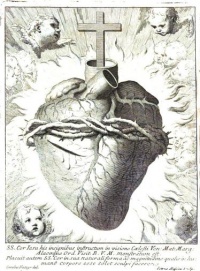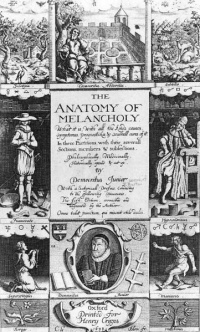Anatomy
From The Art and Popular Culture Encyclopedia


|
"I wanted to study man thoroughly, to dissect him fibre by fibre with an inexorable scalpel, and to watch him, alive and palpitating, on my dissecting-table."--Mademoiselle de Maupin (1835) by Théophile Gautier |
|
Related e |
|
Featured: |
Anatomy (from the Greek anatomia, from ana: separate, apart from, and temnein, to cut up, cut open) is the branch of biology that is the consideration of the structure of living things. Anatomy should not be confused with histopathology (also called anatomical pathology or morbid anatomy), which is the study of the gross and microscopic appearances of diseased organs.
Contents |
Early modern anatomy
The works of Galen and Avicenna, especially The Canon of Medicine which incorporated the teachings of both, were translated into Latin, and the Canon remained the most authoritative text on anatomy in European medical education until the 16th century. The first major development in anatomy in Christian Europe, since the fall of Rome, occurred at Bologna in the 14th to 16th centuries, where a series of authors dissected cadavers and contributed to the accurate description of organs and the identification of their functions. Prominent among these anatomists were Mondino de Liuzzi and Alessandro Achillini.
The first challenges to the Galenic doctrine in Europe occurred in the 16th century. Thanks to the printing press, all over Europe a collective effort proceeded to circulate the works of Galen and Avicenna, and later publish criticisms on their works. Vesalius was the first to publish a treatise, De humani corporis fabrica, that challenged Galen "drawing for drawing" travelling all the way from Leuven to Padua for permission to dissect victims from the gallows without fear of persecution. His drawings are triumphant descriptions of the, sometimes major, discrepancies between dogs and humans, showing superb drawing ability. Many later anatomists challenged Galen in their texts, though Galen reigned supreme for another century.
A succession of researchers proceeded to refine the body of anatomical knowledge, giving their names to a number of anatomical structures along the way. The 16th and 17th centuries also witnessed significant advances in the understanding of the circulatory system, as the purpose of valves in veins was identified, the left-to-right ventricle flow of blood through the circulatory system was described, and the hepatic veins were identified as a separate portion of the circulatory system. The lymphatic system was also identified as a separate system at this time.
17th and 18th centuries
The study of anatomy flourished in the 17th and 18th centuries. The advent of the printing press facilitated the exchange of ideas. Because the study of anatomy concerned observation and drawings, the popularity of the anatomist was equal to the quality of his drawing talents, and one need not be an expert in Latin to take part.
Many famous artists studied anatomy, attended dissections, and published drawings for money, from Michelangelo to Rembrandt. For the first time, prominent universities could teach something about anatomy through drawings, rather than relying on knowledge of Latin. Contrary to popular belief,the church neither objected to nor obstructed anatomical research despite its antagonism towards other scientific practices.
Only certified anatomists were allowed to perform dissections, and sometimes then only yearly. These dissections were sponsored by the city councilors and often charged an admission fee, rather like a circus act for scholars. Many European cities, such as Amsterdam, London, Copenhagen, Padua, and Paris, all had Royal anatomists (or some such office) tied to local government. Indeed, Nicolaes Tulp was Mayor of Amsterdam for three terms. Though it was a risky business to perform dissections, and unpredictable depending on the availability of fresh bodies, attending dissections was perfectly legal. Many anatomy students traveled around Europe from dissection to dissection during the course of their study - they had to go where a fresh body was available (eg after a hanging) because before refrigeration, a body would decay rapidly and become unsuitable for examination.
Many Europeans interested in the study of anatomy traveled to Italy, then the center of anatomy. Only in Italy could certain important research methods be used, such as dissections on women. M. R. Columbus and Gabriele Falloppio were pupils of Vesalius, the 16th century anatomist. Columbus, as his immediate successor in Padua, and afterwards professor at Rome, distinguished himself by rectifying and improving the anatomy of the bones, by giving correct accounts of the shape and cavities of the heart, of the pulmonary artery and aorta and their valves, and tracing the course of the blood from the right to the left side of the heart, by a good description of the brain and its vessels, and by correct understanding of the internal ear, and the first good account of the ventricles of the larynx. Osteology at nearly the same time found an assiduous cultivator in Giovanni Filippo Ingrassias.
Illustrations
Engravings
- Woman seated on the stool[1] is a woodcut from "De dissectione partium corporis humani" Paris 1545, from Charles Estienne (1504 - 1564).
- Man leaning against the tree[2] is a print from "De humani corporis fabrica libri decem" Venice 1627 by Giulio Cesare Casseri (1552 - 1616) and Adriaan van den Spieghel (1578 - 1625) from drawings by Odoardo Fialetti, engravings by Francesco Valesio.
Paintings
- Anatomy lesson of Dr. Willem van der Meer, 1617
- The Anatomy Lesson of Dr. Nicolaes Tulp by Rembrandt shows an anatomy lesson taking place in Amsterdam in 1632.
- The Anatomist, (1869) by Gabriel von Max
- Péan and his surgery class before operation (1887) by Henri Gervex
- The Agnew Clinic (1889) by American artist Thomas Eakins
- Heart's Anatomy (1890) by Enrique Simonet
- History and bibliography of anatomic illustration in its relation to anatomic science and the graphic arts
See also
General anatomy:

